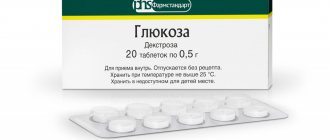Pharmacological properties of the drug Gabagamma
Gabapentin is a cyclic structural analogue of GABA, which penetrates well through the BBB. Despite its structural similarity to GABA, gabapentin is not a GABA mimetic or GABA-α and GABA-β receptor agonist. It also does not interact with benzodiazepine, glutamate, N-methyl-D-aspartate and strychnine-insensitive glycine receptors. However, highly specific (as yet unidentified) gabapentin binding centers have been identified in the neocortex and hippocampus of the animal brain. Thus, the mechanism of the antiepileptic effect of the drug remains unclear today. Bioavailability is disproportionate to the dose: with increasing dose it decreases, and at a dose of 300 mg it is 60%, at a dose of 1600 mg - 30%, respectively. Absolute bioavailability - 60%. Foods, including those high in fat, do not affect pharmacokinetics. The time required to achieve maximum concentration is 2–4 hours. Plasma concentration is proportional to the dose. The maximum concentration is 4.02 mcg/ml when used at a dose of 300 mg every 8 hours and 5.5 mcg/ml when used at a dose of 400 mg. AUC, respectively, is 24.8 and 33.3 mcg/ml/h. Penetrates through the blood-brain barrier and enters breast milk. Distribution volume - 57.7 l. In patients with epilepsy, the concentration in the CSF is approximately 20% of the corresponding equilibrium concentrations of the drug in the blood plasma. The binding to plasma proteins is very weak (less than 5%). It is practically not metabolized, does not induce oxidative enzymes with mixed function, which take part in the metabolism of the drug. Excreted by the kidneys. Removal from blood plasma has a linear relationship. The half-life is on average 5-7 hours, does not depend on the dose (at a dose of 300 mg - 5.2 hours, 400 mg - 6.1 hours). Excreted during hemodialysis. The clearance of gabapentin from blood plasma is reduced in elderly people and in patients with impaired renal function; the half-life with a creatinine clearance of 30 ml/min is 52 hours. Pharmacokinetics do not change with repeated use.
Pharmacodynamics
The exact mechanism of action of gabapentin is unknown. The chemical structure of gabapentin is similar to that of the neurotransmitter gamma-aminobutyric acid (GABA), but its mechanism of action differs from other drugs that interact with GABA receptors (valproate, barbiturates, benzodiazepines, GABA transaminase inhibitors, GABA reuptake inhibitors, GABA agonists and prodrugs GABA).
in vitro studies
With radiolabeled gabapentin, new areas of drug binding to proteins were discovered in the rat brain, incl.
neocortex and hippocampus, which may be related to the anticonvulsant and analgesic activity of gabapentin and its derivatives. Preliminary studies have shown that gabapentin binds to the α2,δ subunit of voltage-gated calcium channels and reduces the flow of calcium ions, which plays an important role in neuropathic pain. At clinically significant concentrations, gabapentin does not bind to other common drug and neurotransmitter receptors present in the brain, incl. GABAA, GABAB, benzodiazepine, glutamate, glycine and N-methyl-d-aspartate receptors. Unlike phenytoin and carbamazepine, gabapentin does not interact with sodium channels in vitro
.
In vitro
use of gabapentin results in minor release of monoamine neurotransmitters. Administration of gabapentin to rats increased the rate of GABA metabolism in some brain regions, similar to the effect of sodium valproate, but the effect was observed in other brain regions. The connection between the described effects of gabapentin and its anticonvulsant activity has not currently been established. In animals, gabapentin easily penetrates into the brain tissue and prevents seizures provoked by maximum electric shock, chemical convulsants, incl. inhibitors of GABA synthesis, as well as in the case of genetic models of convulsive syndromes.
Clinical trials of adjuvant treatment of partial-onset seizures in children aged 3 to 12 years demonstrated a quantitative but non-significant difference in the rate of seizure reduction of 50% in the gabapentin group compared with the placebo group. Additional analysis of the response rate to therapy depending on age (when considering age as a continuous variable or when distinguishing two age subgroups of 3–5 and 6–12 years) did not reveal a statistically significant effect of age on the effectiveness of therapy.
Use of the drug Gabagamma
The dosage is determined by the doctor depending on individual tolerance and effectiveness of the drug. For individual dose selection, drugs of 100, 300, 400 mg are used. Epilepsy The effective dose is 900–3600 mg of gabapentin per day. Adults and adolescents Treatment begins with a dose of 300 mg. Increasing the dose until a clinical effect is achieved can be carried out quickly, over several days, when on the 1st day 300 mg is taken 1 time per day, on the 2nd day - 300 mg 2 times a day and on the 3rd day - 300 mg 3 once a day, in accordance with the treatment regimen:
Day of taking the drug | Morning dose | Daily dose | Evening dose |
| Day 1 (300 mg) | – | – | 300 mg |
| Day 2 (600 mg) | 300 mg | – | 300 mg |
| Day 3 (900 mg) | 300 mg | 300 mg | 300 mg |
As an alternative, an initial dose of 300 mg gabapentin (900 mg gabapentin per day) 3 times daily is possible. After this, the daily dose can be increased to 1200 mg divided into 3 single doses and, if necessary, further increased by 300 mg per day divided into 3 single doses to a maximum daily dose of 3600 mg. If a higher dose of the drug is needed and its increase occurs quickly, the risk of dizziness during the titration phase increases. The time interval between taking the evening dose and the next morning dose should be no more than 12 hours to avoid the occurrence of new epileptic seizures. Associated pain with diabetic neuropathy and postherpetic neuralgia The usual dose is 1800–2400 mg per day; in some cases it may be necessary to increase it to a maximum of 3600 mg per day. Adults Treatment begins with a dose of 100–300–400 mg. Increasing the dose until a clinical effect is achieved can be carried out quickly, over several days, when on the 1st day 100–300–400 mg is taken 1 time per day, on the 2nd day - 100–300–400 mg 2 times a day and on the 3rd day - 100–300–400 mg 3 times a day, in accordance with the treatment regimen:
Day of taking the drug | Morning dose | Daily dose | Evening dose |
| Day 1 (100–300–400 mg) | – | – | 1 capsule |
| Day 2 (200–600–800 mg) | 1 capsule | – | 1 capsule |
| Day 3 (300–900–1200 mg) | 1 capsule | 1 capsule | 1 capsule |
After this, the dose is increased to 1800 mg per day over the course of a week, divided into 3 single doses. The following week, if necessary, the dose can be increased to 2400 mg per day, divided into 3 single doses. If necessary, it can be further increased by 300 mg per day, divided into 3 doses until the maximum dose is reached, which is 3600 mg per day. Increasing the dose to maintenance should be done slowly to prevent possible side effects. The time interval between taking the evening dose and the next morning dose should be no more than 12 hours. For patients with impaired renal function and in elderly patients, it is recommended to reduce the dose, since their renal function may be altered. Such patients need to select doses individually. Patients who are on hemodialysis The initial dose of the drug is 100–300–400 mg, followed by a maintenance dose: 200–300 mg of gabapentin after an appropriate 4-hour hemodialysis. If hemodialysis is not performed, gabapentin is not taken. For patients with unsatisfactory general condition, low body weight, or after organ transplantation, the dose of the drug should be increased gradually, prescribing 100 mg of gabapentin per capsule. Treatment for epilepsy is long-term. The doctor must independently decide in which case a forgotten dose of gabapentin (for example, the last dose taken more than 12 hours ago) should be compensated for with an additional dose that will need to be taken later. Capsules are taken orally, regardless of meals, with a sufficient amount of water, without chewing.
Side effects of the drug Gabagamma
from the cardiovascular system: symptoms of vasodilation, increased blood pressure; from the digestive system: dyspepsia; rarely - nausea, vomiting, abdominal pain, increased appetite; in isolated cases - dry mouth, constipation or diarrhea, pancreatitis, increased activity of liver transaminases, flatulence, anorexia, gingivitis. from the musculoskeletal system: rarely - myalgia, arthralgia, back pain; from the nervous system: drowsiness, dizziness, ataxia, nystagmus (dose-dependent), tremor, dysarthria, increased nervous excitability; rarely - headache, amnesia, depression; in isolated cases - thinking disorders, confusion, tic, paresthesia (dose-dependent), asthenia, hyperkinesia; hypo- or areflexia, anxiety, insomnia; from the respiratory system: rarely - rhinitis, pharyngitis, cough, pneumonia; from the genitourinary system: in isolated cases - urinary incontinence, decreased potency, urinary tract infections; from the senses: visual impairment (diplopia, amblyopia), ringing in the ears; from the hematopoietic organs: in isolated cases - leukopenia, thrombocytopenic purpura; allergic reactions: in isolated cases - skin rashes, itching, chills, exudative erythema multiforme (including Stevens-Johnson syndrome); others: weight gain, in isolated cases - peripheral edema, discoloration of tooth enamel, acne, facial swelling, changes in blood glucose levels in patients with diabetes, increased bone fragility.
Special instructions for the use of the drug Gabagamma
Reducing the dose, discontinuing the drug or replacing it with another (alternative) should be carried out gradually, over a period of at least 1 week. Abrupt cessation of treatment with antiepileptic drugs in patients with epilepsy can provoke status epilepticus. Caution should be exercised when treating patients with a history of psychosomatic illnesses. Patients with rare hereditary galactose intolerance, lactose deficiency or glucose and galactose malabsorption should not take this medicinal product. The use of alcohol and drugs may increase the side effects of gabapentin on the central nervous system, such as obnibulation of consciousness and ataxia. The use of the drug during pregnancy and lactation is possible only when the expected benefit to the mother's body outweighs the potential risk to the fetus or child. When using the drug, you should refrain from driving vehicles and working with potentially dangerous mechanisms. Gabapentin is not recommended for the treatment of epilepsy in children under 12 years of age, as well as for the treatment of diabetic neuropathy and postherpetic neuralgia in adolescents under 18 years of age, which are accompanied by pain, since experience with the drug in these groups is limited.
Manufacturer
Verwag Pharma GmbH & Co. KG, Calver Strasse 7, 71034 Böblingen, Germany.
Manufacturer of the finished dosage form. Dragenopharm Apotheker Püschl GmbH, Gellstraße 1, 84529 Tittmoning, Germany.
Manufacturer (producing quality control). Medis International a.s., Czech Republic, production plant in Bolatice, Promyslova 961/16, 747 23 Bolatice.
An organization that receives consumer complaints. Representative office (Germany), 117587, Moscow, Varshavskoe sh., 125 Zh., bldg. 6.
Tel..
Drug interactions Gabagamma
Possible simultaneous use with other antiepileptic drugs (phenytoin, carbamazepine, valproic acid, phenobarbital), with oral contraceptives (containing norethindrone and/or ethinyl estradiol), with drugs that block tubular secretion and reduce the excretion of gabapentin by the kidneys. Antacids that contain Al3+ and Mg2+ reduce the bioavailability of gabapentin by approximately 20%. Gabapentin is recommended to be taken 2 hours after taking the antacid drug. Myelotoxic drugs - increased hematotoxicity (leukopenia).
Overdose
Symptoms
(with a single dose of 49 g of gabapentin): dizziness, diplopia, speech impairment, drowsiness, lethargy, lethargy, loss of consciousness, diarrhea. It should be taken into account that when taking high doses of gabapentin, its absorption in the intestine decreases. In case of an overdose of gabapentin, coma may develop, especially when used simultaneously with other drugs that depress the central nervous system. Although gabapentin can be eliminated by hemodialysis, current experience shows that this is not usually necessary.
In experiments on mice and rats, to which the drug was administered in doses of up to 8000 mg/kg, it was not possible to establish the lethal dose of gabapentin when administered orally. Signs of acute toxicity in animals included ataxia, difficulty breathing, ptosis, hypoactivity or agitation.
Treatment:
gastric lavage, administration of activated carbon, symptomatic therapy. Hemodialysis may be indicated for patients with severe renal failure.






